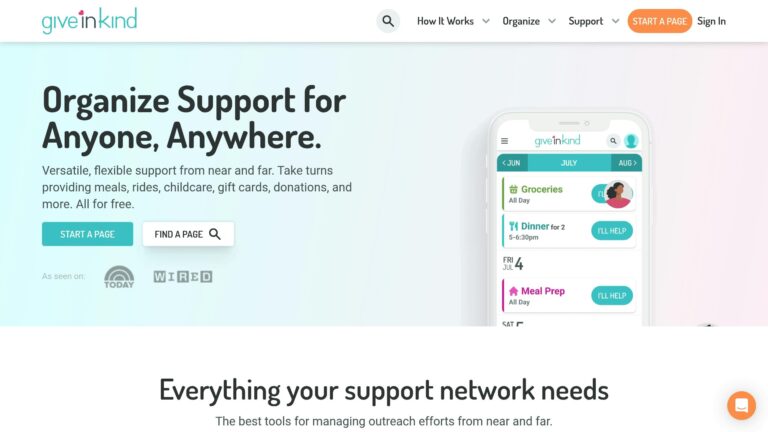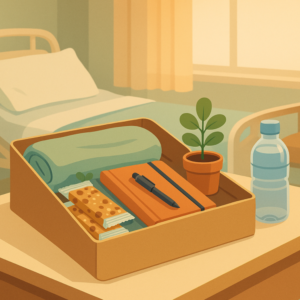Creating a hospital care package? Here’s what you need to know to make it comforting, practical, and hospital-friendly:
What to Include:
- Comfort & Hygiene: Non-slip socks, light blankets, unscented toiletries (dry shampoo, lip balm).
- Entertainment: Puzzle books, magazines, headphones, or a tablet with movies.
- Daily Basics: Extra-long phone charger, neck pillow, soft tissues.
- Personal Touch: Photos, handwritten notes, or sentimental items like a stuffed animal.
What to Avoid:
- Scented products, fresh flowers, unwrapped food, personal medications.
- Bulky or hard-to-clean items, and anything restricted by hospital policies.
Key Tips:
- Check hospital rules before packing.
- Use lightweight, easy-to-carry packaging.
- Coordinate delivery timing with the patient or hospital staff.
A thoughtful care package can brighten someone’s hospital stay. Focus on comfort, practicality, and personal touches while respecting hospital guidelines.
What to Pack for an Overnight or Extended Hospital Stay
Putting together a thoughtful hospital care package means balancing practical needs with personal touches.
Comfort and Hygiene Essentials
Help make a hospital room feel more welcoming with these items:
- Non-slip socks for safety and warmth
- A light blanket or throw for added coziness
- Unscented travel-size toiletries, such as:
- Gentle shampoo
- Fragrance-free lotion
- Alcohol-free mouthwash
- Dry shampoo
- Lip balm
“My stepdaughter brought me some fragrance-free lotion and a can of dry shampoo! Then she brushed it through my hair. It felt so good." – Kathryn C. [1]

Activities to Pass the Time
Long hospital stays can be tedious, so include things to keep the patient entertained:
- Large-print books or magazines
- Puzzle books
- A tablet loaded with movies and audiobooks
- Wireless headphones
- A Bluetooth speaker for music or podcasts
Daily Basics
These simple items can make a big difference in comfort:
- An extra-long phone charger to stay connected
- A travel neck pillow to help with the extended bed rest
- Soft tissues for sensitive skin
- High-quality toilet paper for a small but meaningful upgrade
“Silly but it made me smile and turned out to be the best gift. I gift this to all my hospitalized loved ones now. It’s a roll of really soft toilet paper. Pamper yourself in the small ways to get through the days! It’s affordable and ended up being really appreciated." – Mindy S. M. [1]
Adding a Personal Touch
Make the package feel special by including:
- Family photos to bring a sense of home
- A comfort object like a favorite blanket or stuffed animal
- Handwritten cards to brighten their day
- Familiar items from home that hold sentimental value
How Give InKind Can Help

For the personal touch that goes above and beyond, the Give InKind platform offers tools to simplify the process:
-
- Create a Wishlist for specific items the patient needs
- Use the Care Calendar to organize visits and deliveries
- Manage gift cards with the Give InKind Wallet
- Direct donors to Fundraising options with no extra fees
- Share Updates about progress and preferences to keep everyone informed
With a thoughtful and practical mix of support options, Give InKind can help with all around support during a hospitalization and beyond. Unite your entire support network in one convenient place, all for free.
What Not to Pack
When preparing a care package for a hospital stay, it’s essential to follow hospital rules to avoid any issues. Knowing what to leave out ensures your package provides comfort without causing complications.
Hospital Rules and Safety
Hospitals have strict policies to protect patients and reduce infection risks. Always check the specific hospital’s guidelines, especially for specialized units like ICUs, pediatric wards, or oncology departments.
Here’s what to avoid:
- Scented products: Perfumes, lotions, or other fragrant items can cause allergies or breathing problems.
- Fresh flowers and plants: These are often restricted, especially in areas with transplant or immunocompromised patients, due to infection concerns.
- Unwrapped food items: Open or perishable foods can carry bacteria.
- Personal medications: These might interfere with the patient’s prescribed treatments.
- Unsanitized electronics: Devices like phones can carry up to 10 times more bacteria than other surfaces [2].
Always follow your hospital’s specific rules. Additionally, avoid bringing items that are large or difficult to store, as they can disrupt patient care.
Space and Storage Limits
Hospital rooms often have limited space, so consider these restrictions:
- Bulky decorations: These can block access to medical equipment.
- Large or valuable items: Storage is limited, and security for personal belongings may be minimal.
- Hard-to-clean items: Certain stuffed animals or fabric decorations can be difficult to sanitize.
- Excess clothing: Multiple outfits may be hard to store in a small hospital room.
Medical staff require clear access to both patients and equipment. For the most up-to-date storage guidelines, consult with hospital staff before packing.
Packing and Delivery Steps
Best Packing Tips
Packing thoughtfully makes a care package more useful and organized. Choose a container that’s easy to carry and fits well in a hospital room. To keep things tidy and accessible, try grouping similar items into smaller bags or compartments.
Here are some tips for assembling your care package:
- Organize by category: Keep similar items together, like snacks, hygiene products, or entertainment items, so they’re easy to find.
- Use labels: Clearly label containers, especially for items like medications or dietary snacks.
- Protect fragile items: Wrap delicate things in bubble wrap or soft clothing to avoid damage.
- Add personal touches: Include a heartfelt note or a few photos to make the package feel more special.
Keep the package lightweight so it’s easier to handle and transport.
Delivery Guidelines
Once your care package is ready, follow these steps to ensure smooth delivery to the hospital.
Since visitor restrictions can vary, always check the hospital’s current rules before attempting delivery.
- Check Hospital Policies
Call the hospital’s information desk to confirm their visitor policies, delivery hours, and any specific restrictions. - Plan the Timing
Contact the patient ahead of time to make sure they’re available when you plan to deliver the package. - Consider Alternatives
If you can’t deliver the package in person, try these options:- Send a digital gift card through a Give InKind support page.
- Use Give InKind’s Care Calendar to coordinate deliveries with other visitors.
- Avoid overwhelming the patient by scheduling deliveries and visits through the Care Calendar.
Summary
Creating a thoughtful care package means balancing comfort, practicality, and hospital guidelines. Choose items that bring ease and relaxation while respecting space and safety rules. Consider essentials like soft blankets, non-slip socks, extra-long phone chargers, and unscented personal care items.
Entertainment can also make a big difference. Items like magazines and puzzle books are great options for passing the time. As one patient shared:
“Magazine to browse. Couldn’t concentrate enough to read a book, but a magazine was perfect." – Linda M. B.[3]
To ensure your care package truly helps, coordinate deliveries through Give InKind’s Care Calendar. This helps track needs and avoids overwhelming visits.
Keep in mind that hospital rooms often have limited space, so focus on items that are versatile. Always check specific hospital policies about restricted items, especially food, flowers, and scented products. If you’re unsure, contact the hospital’s information desk for clarification.
The key is to combine practicality with care, creating a package that offers comfort while adhering to hospital guidelines.

FAQs
How can I make a hospital care package more personal while following hospital rules?
To create a thoughtful and personalized hospital care package, start by including items that bring comfort and familiarity. Add small personal touches like a family photo, a handwritten note, or a favorite blanket to remind the patient of home. For entertainment, consider puzzle books, magazines, or a tablet preloaded with movies or games to help pass the time. Practical items like unscented lotion, lip balm, or cozy socks can also be comforting and useful in a hospital setting.
Before assembling your package, make sure to check the hospital’s guidelines to ensure all items are appropriate and allowed. Some hospitals may have restrictions on food, flowers, or certain materials, so confirming these details will help you create a package that is both meaningful and compliant.
What should I consider to ensure my care package items are safe and allowed in the hospital?
To make sure your care package is both safe and hospital-approved, start by reviewing the specific guidelines of the hospital where the patient is staying. Many facilities have rules against items like fresh flowers, plants, or certain foods due to health and safety concerns.
When choosing items, consider the patient’s needs and potential sensitivities. Avoid anything with strong scents or allergens, and if including snacks, check for dietary restrictions or allergies. Thoughtful planning ensures your care package is both meaningful and appropriate.
What are some ways to send a care package if I can’t visit the hospital in person?
If visiting the hospital isn’t an option, you can still send a thoughtful care package through delivery services. Many online retailers offer a wide range of items perfect for hospital patients, such as cozy blankets, books, or personal care products.
Consider coordinating support through a personalized page on Give InKind. Loved ones from all over can contribute to providing extended care throughout the hospital stay and beyond.
Helpful Products
Give InKind does not provide medical advice, diagnosis, or treatment. We have an affiliate relationship with many of the advertisers on our site, and may receive a commission from any products purchased from links in this article. See Terms & Conditions.





